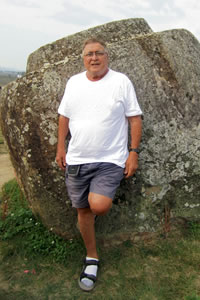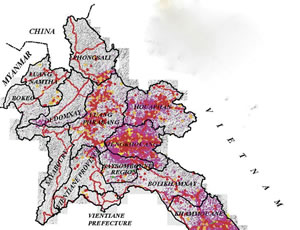The U.S. Secret Bombing Of Laos

The author at the Plain of Jars
I recently traveled to north Laos and saw the damage done by U.S. bombing there from 1964 to 1973.
If we bombed Laos, you may be thinking, why is this the first you’ve heard about it?
Well, nobody told us when it was happening and we didn’t know how bad it was afterward.
Until now.
Look at it on the newly released chart (see the accompanying U.S. Air Force graphic). More tonnage of American bombs was dropped on Laos during the Vietnam War than on our enemies’ countries in all of World War II – blockbuster
2,000-pounders and 260 million cluster bombs that only exploded 70 percent of the time. The rest lie in wait for a farmer or a curious child.
They’ve killed and wounded 35,000 in Laos since the war. That’s an average of two to three casualties every day over 37 years. I have seen the craters and the decimated forests of Houaphan and Xiang Khoang provinces. I’ve seen the evidence of our bombing of the Plain of Jars, where huge stone jars were carved by unknown people for unknown reasons from 500 B.C. to 200 A.D.
Why did we do it?

Red denotes bombed areas in this U.S. Air Force graphic. Photos from Bob Jones
Because communist Pathet Lao leaders and troops hid there, under then heavy tree canopy and in caves.
I was an NBC correspondent in Laos in 1969. I wanted to get up north because rumors of heavy U.S. bombing were rampant in the capital city of Vientiane, where the tiny press corps was based.
So I asked U.S. ambassador G. McMurtrie Godley for help to me get there. He refused. I said “but TIME magazine is reporting the bombing.” He said: “Ah, Mr. Jones, but nobody has seen the bombing on NBC News.”
In other words, what Americans didn’t see wasn’t happening. Or at least they didn’t care about it. Now we’re seeing our legacy: Dead farmers and children; dead horses and water buffalo. Today, Xam Nua residents use rusty, defused U.S. bombs as yard, business and hotel decorations.
We, New Zealand and UNESCO are still paying for unexploded ordnance disposal. It’s a slow process.
If you visit the Plain of Jars, you must stay on the “white” side of path markers. The “red” side has not been cleared. Most of Xiang Khouang Province has not been cleared.
Interesting note: You can go into a one-star hotel or dingy Internet cafe or home with a computer in any small town in Laos or Vietnam and pull up Web porno sites. It’s not censored, and that greatly surprised me. But don’t bother looking for chat rooms or Google sites suggesting that multiple political parties are better than the one – the Communist Party. My searches did not find any.



